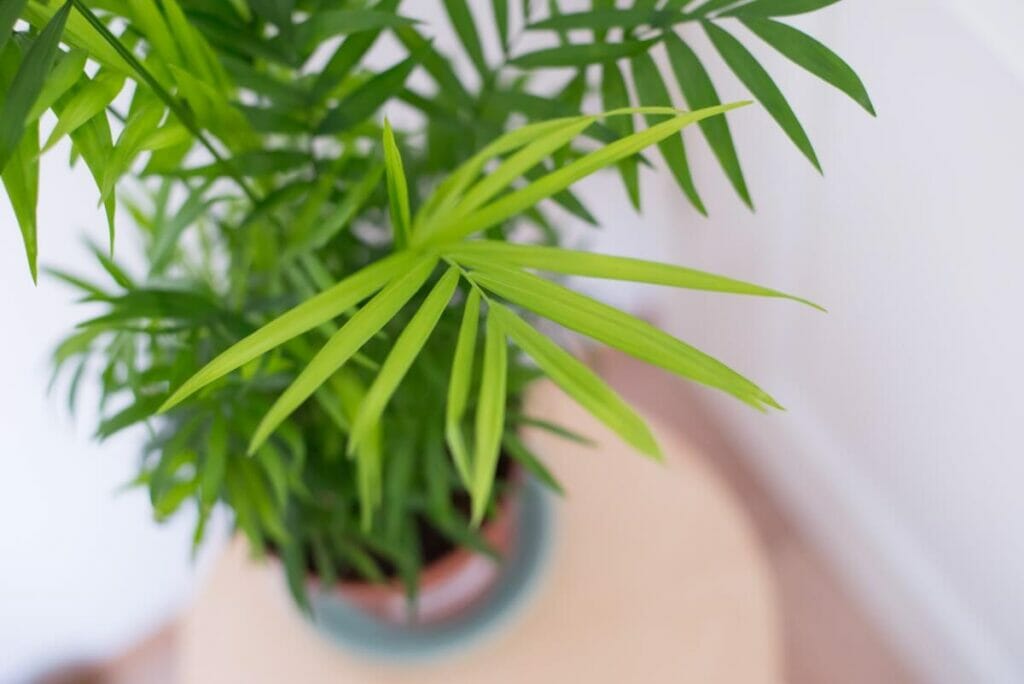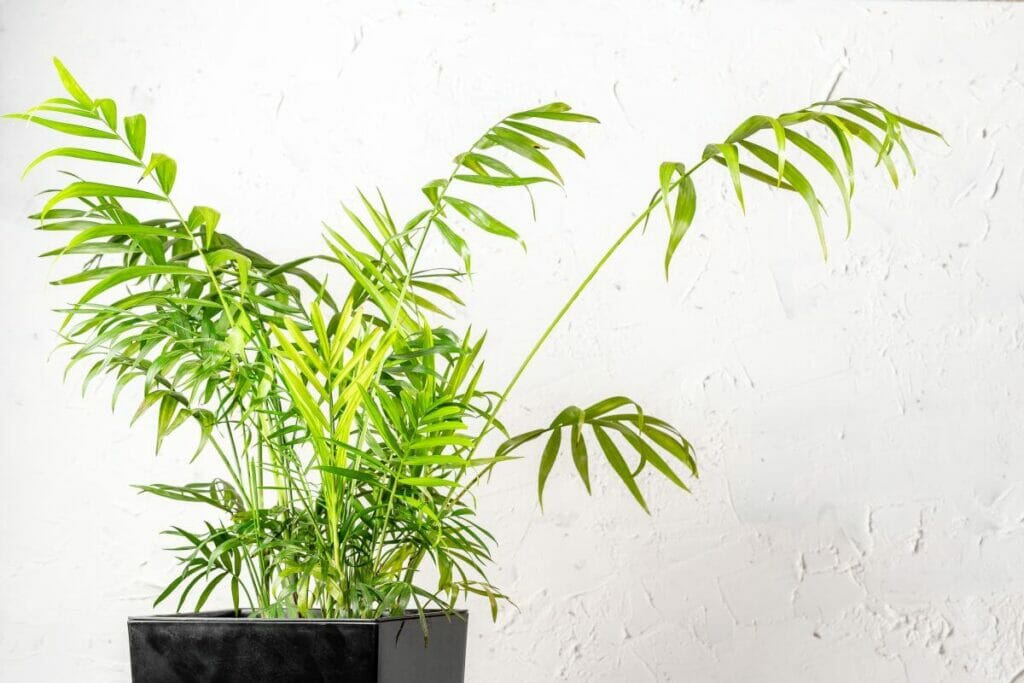How to Water Parlor Palm Plants for Optimal Growth at Home
I find that parlor palms (Chamaedorea elegans) are generally easy to care for as long as you provide them with an appropriate watering schedule. In this guide, I’ll share how I water mine at home, including the best types of water to use and seasonal considerations to be aware of.

Key Takeaways
Parlor palms require watering every 7 to 10 days in spring and summer and every 10 to 14 days in winter, ensuring soil remains evenly moist without getting waterlogged in between cycles. Smaller parlor palms require dry topsoil before being watered. For larger, more mature plants, wait for the first 2 inches of topsoil to dry out before watering.
When to Water Parlor Palms

Parlor palms have specific water requirements and preferences. The following includes some handy tips to remember when watering your Parlor plants.
When watering your Parlor palm plant, remember that these types of palms do not like heavy, waterlogged soil bases. They prefer moderately moist soils that don’t dry out completely in between watering cycles.
How to Check When to Water a Parlor Palm
The finger test is your best bet when checking if your Palor palm needs water. I do this by simply sticking my finger into the topsoil. You should find that the topsoil is dry for smaller plants before giving your plant any water. With bigger plants, ensure that the first two inches of topsoil is dry before watering your plant.
How Often Do Parlor Palms Typically Need Watering?
Generally, I water my parlor palm every 7 to 10 days in summer and every 10 to 14 days during the late fall and winter months.
Environmental Considerations
Warmer climates will necessitate watering your Parlor palm more often than colder climates. You should also be prepared to water your Parlor palm more often if you place it in a room with bright indirect sunlight, such as near a south-facing window, and less if it lives in a room that receives low light, one that is near a north-facing window.
How to Water

Knowing how to water your Parlor palm plant is just as crucial as knowing when to water your plant. Let’s look at some fundamental aspects of understanding how to water your Parlor palm plant.
The Fundamental Importance of Good Drainage
When it comes to Parlor palm plants, they do not appreciate waterlogged soil. Waterlogged plants resulting from inadequate drainage can result in various diseases and root rot, which can ultimately cause the end of your plant. Your pot and soil need to have good drainage to prevent this from happening.
What Type of Water Is Best?
Parlor palm plants hail from the tropical rainforests of Guatemala and southern Mexico. Due to this, their roots prefer warmer water. Therefore, it would be best to water your Parlor plants with lukewarm water as the cold water can shock the roots and ultimately cause adverse reactions in your plant.
The Best Watering Techniques
I find the easiest method is the top-down approach with a watering can. These plants prefer not to have their feet sitting in water, which rules out the bottom-up approach.
Step-by-Step Guide for Top Watering
When you water your Parlor palm plant, ensure water is aimed all around the base. Do not leave any topsoil dry, as this can cause frond loss.
How Much Water Do You Add?
I water my parlor palms continuously until water starts seeping out of the drainage holes in the plant pot. The size of your plant’s container will depend on the amount of water required, with smaller containers needing less water than larger ones.
A 10 – 12 inches wide container will need around ¾ of a gallon of water; anything smaller will need less water, and anything more significant will need more water.
Parlor palms do not like soggy or wet feet. For this reason, removing all excess water from your saucer or tray within an hour after watering your plant is a good idea.
Signs You Might Be Overwatering
Parlor palms will tell you if you are overwatering them. Some signs of overwatering include:
- Brown tipped leaves
- Sour-smelling, mushy stems
- Drooping leaves
- Root rot
Signs You Might Be Underwatering
Like overwatering, your Palor palm will let you know if it has not received enough water. Some of the signs of underwatering include:
- Yellow leaves
- Drooping leaves
- Stunted growth
What to Do In Between Watering Cycles

How and when you water your Parlor palm are crucial steps in your plant care regime, but is there anything else you should be doing in between the watering cycles?
Misting
If you notice that your Parlor palm plant leaves are getting a bit crispy on the edges, you might find that your plant would benefit from a good misting. If you live in an arid area, you can opt to give your Parlor palm a misting every week or so during the summer months.
Humidity Trays
Parlor palms are hardy plants and will thrive in average humidity conditions. Therefore, there is no reason to use a humidity tray for your parlor palm.
Main Things to Keep an Eye On
Keeping an eye on your Parlor palm’s leaves is prudent between watering cycles. Are they wilting, turning yellow, or getting brown edges? Keep your eye on the topsoil to ensure your plant is not drying out too much between watering. If your plant maintains its vibrant, healthy look, everything should be fine.
For more, see our in-depth guide on where to position Parlor palms in the home for optimal care and Feng Shui benefits.
The Role of Water in Plant Health and Development
Water is essential to life, playing a crucial role in plants’ health and development. Water plays a vital role in photosynthesis, whereby plants use water, CO2, and sunlight to convert into glucose, a food source.
A plant’s roots absorb water, carrying nutrients and sugars from the soil. The water will then travel from the roots up the plant to the stems and into the leaves, fruit, or flowers.
The correct water balance is necessary to keep your plant nourished. Water evaporates through the leaves, which causes more water to be absorbed through the roots, creating a sort of circulatory system helping to keep your parlor palm’s temperature regulated. This process is called transpiration.
Wrapping Up
Parlor palms prefer a watering regime that consists of a top-down approach with a watering can, which can be administered 1 – 2 times a week in summer and 1 – 2 times every two weeks in winter. Parlor palms do not like to be waterlogged, so ensure that the topsoil of smaller plants and the first inch of topsoil in larger plants are dry before watering.
Further reading: Discover the best types of indoor palm trees.
Andrew is the Editorial Director at Petal Republic. He holds a BSc degree in Plant Sciences and has trained professionally at leading floristry schools in London and Paris. In amongst overseeing a global editorial team, Andrew's a passionate content creator around all things flowers, floral design, gardening, and houseplants.
